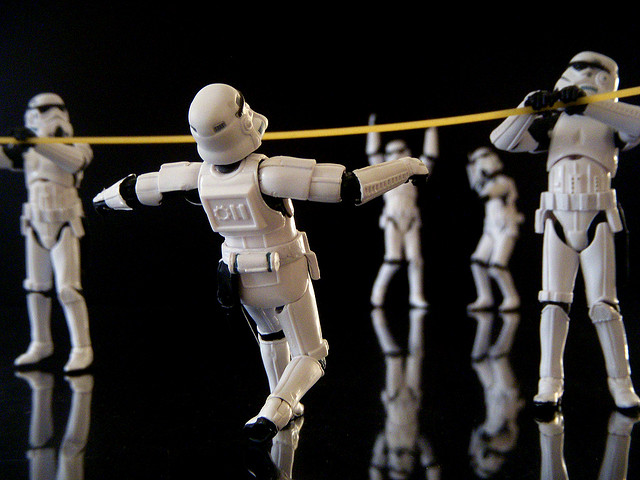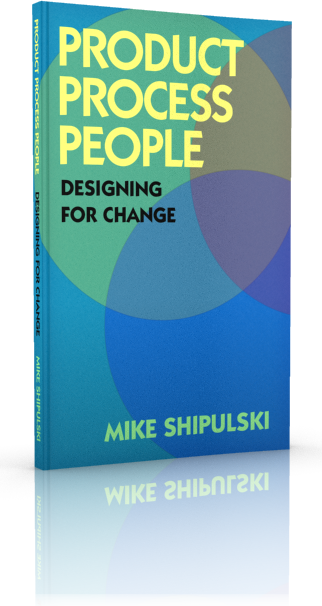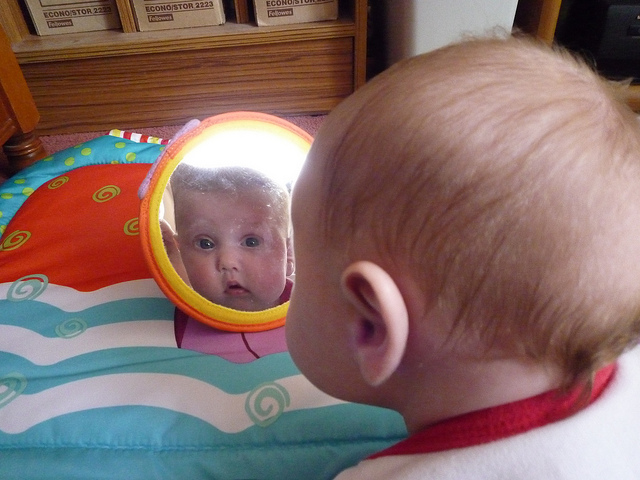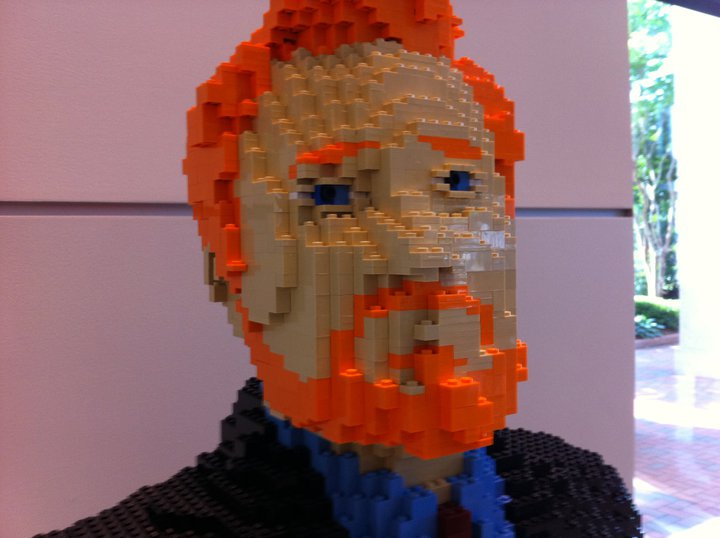Archive for the ‘Seeing Things As They Are’ Category
Weak Signals And The Radical Fringe
We strive to get everyone on the same page, to align the crew in a shared direction. The thinking goes – If we’re all pulling in the same direction, we’ll get there faster and more efficiently. Yes, the destination will come sooner, but what if it’s not there when we get there?
There’s implicit permanence to our go-forward travel plans. We look out three years and plan our destination as if today’s rules and fundamentals will still apply. We think – That imaginary tropical vacation spot will be beautiful in three years because it looks beautiful through the kalidascope of today’s success. But as the recent natural disasters have taught us, whole islands can be destroyed in an instant. But still, the impermenance of today’s tried-and-true business models is lost on us, and we see the unknowable future as statically as the unchangeable map of the continents.
Thing is, all around us there are weak indications the fundamental tradewinds have started to shift – weak signals of impermenance that may invalidate today’s course heading. But weak signals are difficult to hear – the white noise of yesterday’s success drowns out the forward-looking weak signals. And more problematic, once heard, weak signals are easily dismissed because their song threatens the successful status quo.
You feel weak signals in your chest. It could be a weak signal when your experience tells you things should go one way and they actually go another. Martin Zwilling (Forbes) has some great examples. (Thanks to Deb Mills-Scofield [@dscofield] for retweeting the article.)
100% alignment reduces adaptability because it deadens us to weak signals, and that’s a problem in these times of great impermanence. To counter the negative elements of alignment, there must be a balancing injection of healthy misalignment. This is an important and thankless task falls on the shoulders of a special breed – the radical fringe. They’re the folks smart enough to knit disjointed whispers into coherent ideas that could unravel everything and brave enough to test them.
Disruptive movements and revolutions build momentum quietly and slowly. But if you can recognize them early, there’s a chance you can get into position to ride their tsunami instead of being ambushed and scuttled by it. But you’ve got to listen closely because these young movements are stealthy and all they leave in their wake are weak signals.
Tracking Toward The Future
 It’s difficult to do something for the first time. Whether it’s a new approach, a new technology, or a new campaign, the mass of the past pulls our behavior back toward itself. And sadly, whether the past has been successful or not, its mass, and therefore it’s pull, are about the same. The past keeps us along the track of sameness.
It’s difficult to do something for the first time. Whether it’s a new approach, a new technology, or a new campaign, the mass of the past pulls our behavior back toward itself. And sadly, whether the past has been successful or not, its mass, and therefore it’s pull, are about the same. The past keeps us along the track of sameness.
Trains have tracks to enable them to move efficiently (cost per mile), and when you want to go where the train is heading, it’s all good. But when the tracks are going to the wrong destination, all that efficiency comes at the expense of effectiveness. Like we’re on rails, company history keeps us on track, even if it’s time for a new direction.
The best trains run on a ritualistic schedule. People queue up at same time every morning to meet their same predictable behemoth, and take comfort in slinking into their regular seats and turning off their brains. And this is the train’s trick. It uses its regularity to lull riders into a hazy state of non-thinking – get on, sit down, and I’ll get your there – to blind passengers from seeing its highly limited timetable and its extreme inflexibility. The train doesn’t want us to recognize that it’s not really about where the train wants to go.
Trains are powerful in their own right, but their real muscle comes from the immense sunk cost of their infrastructure. Previous generations invested billions in train stations, repair facilities, tight integration with bus lines, and the tracks, and it takes extreme strength of character to propose a new direction that doesn’t make use of the old, tired infrastructure that’s already paid for. Any new direction that requires a whole new infrastructure is a tough sell, and that’s why the best new directions transcend infrastructure altogether. But for those new directions that require new infrastructure, the only way to go is a modular approach that takes the right size bites.
Our worn tracks were laid in a bygone era, and the important destinations of yesteryear are no longer relevant. It’s no longer viable to go where the train wants; we must go where we want.
Transplant Syndrome
 Overall, our upward evolutionary spiral toward infinite productivity is a good thing. (More profit with less work – can’t argue with that.) And also good is our Darwinian desire to increase our chances of realizing profit by winding a thick cocoon of risk reduction around the work.
Overall, our upward evolutionary spiral toward infinite productivity is a good thing. (More profit with less work – can’t argue with that.) And also good is our Darwinian desire to increase our chances of realizing profit by winding a thick cocoon of risk reduction around the work.
But with our productivity helix comes a little known illness that’s rarely diagnosed. It’s not a full-fledged disease, rather, it’s a syndrome. It’s called Transplant Syndrome, or TS.
Along with general flu-like symptoms, TS produces a burning and itching desire to transplant something that worked well in one area into another. On its own, not a bad thing; the dangerous part of TS is that scratching its itch feels so good. And it feels so good because the scratching fits with capitalism’s natural law – only the most productive species will survive.
In a brain suffering from TS, transplanting Region A’s successful business model into Region B makes perfect productivity sense (No new thinking, but plenty of new revenue.) But that’s not the problem. The problem is the TS brain’s urge to transplant is insatiable and indiscriminate. With TS, along with Region B, it makes perfect sense to transplant into Region C, Region D, and Regions L, M, N, O, and P. And with TS, it must happen in record time. Like a parasite, TS feeds on our desire for productivity.
When you transplant your favorite flowering plant from one region of your yard to another, even the inexperienced gardener in us knows to question whether the new region will support the plant. Is the soil similar? Is there enough sun or too much? Will it be blocked from the wind like it is now? And because you know your yard (and because you asked the questions) you won’t transplant unless the viability threshold is met.
But what if you wanted to transplant your most precious flowering plant from your yard in North America to someone else’s yard in South America? At a high level, the viability questions are the same – sun, soil, and water, but the answers are hard to come by. Should you use google to get the answers? Should you get in an airplane and check the territory yourself? Should you talk to the local gardeners? (They don’t speak English.)
But digging deeper, there are many questions you don’t even know to ask. Some of the local bugs may eat your precious plant, so you better know the little crawlies by name and learn what they like to eat. But still, since the bugs have never seen your plant, you won’t know if they’ll eat it until they eat it. You can ask the local gardeners, but they won’t know. (They, too, have never seen it.) Or worse, they may treat it as invasive species and pull it out of the ground after you leave for home.
Here’s an idea. You could scout out local plants that look like yours and declare viability by similarity. But be careful because over the years the local plants have built up tacit defenses you can’t see.
Transplant Syndrome not just a business model syndrome; it infects broadly. In fact, there have been recent outbreaks reported in people that work with products, technologies, processes, and company cultures.
Unfortunately, there is no cure for TS. But, with the right prescription, symptoms can be managed.
Symptoms have been pushed into dormancy when companies hire the best, most experienced, local gardeners. These special gardeners must have been born and raised in-region. And in clinical trials the best results have been achieved when the chief gardener, a well respected local gardener in their own right, has full responsibility for designing, viability testing, and implementing the transplant program.
There have been reported cases of TS symptoms flaring up mid program, but in all cases there was a single common risk factor: no one listened to the gardeners on the receiving end of the transplant.
Choose Yourself
 We’ve been conditioned to ask for direction; to ask for a plan; and ask for permission. But those ways no longer apply. Today that old behavior puts you at the front of the peloton in the great race to the bottom.
We’ve been conditioned to ask for direction; to ask for a plan; and ask for permission. But those ways no longer apply. Today that old behavior puts you at the front of the peloton in the great race to the bottom.
The old ways are gone.
Today’s new ways: propose a direction (better yet, test one out on a small scale); create and present a radical plan of your own (or better, on the smallest of scales test the novel aspects and present your learning); and demonstrate you deserve permission by initiating activity on something that will obsolete the very thing responsible for your success.
People that wait for someone to give them direction are now a commodity, and with commodities it always ends in the death spiral of low cost providers putting each other out of business. As businesses are waist deep in proposals to double-down on what hasn’t worked and are choking on their flattened S-curves, there’s a huge opportunity for people that have the courage to try new things on their own. Today, if you initiate you’ll differentiate.
[This is where you say to yourself – I’ve already got too much on my plate, and I don’t have the time or budget to do more (and unsanctioned) work. And this is where I tell you your old job is already gone, and you might as well try something innovative. It’s time to grab the defibrillator and jolt your company out of its flatline. ]
It’s time to respect your gut and run a low cost, micro-experiment to test your laughable idea. (And because you’ll keep the cost low, no one will know when it doesn’t go as you thought. [They never do.]) It’s time for an underground meeting with your trusted band of dissidents to plan and run your pico-experiment that could turn your industry upside down. It’s time to channel your inner kindergartener and micro-test the impossible.
It’s time to choose yourself.
The Threshold Of Uncertainty
 Our threshold for uncertainty is too low.
Our threshold for uncertainty is too low.
Early in projects, even before the first prototype is up and running, you know what the product must do, what it will cost, and, most problematic, when you’ll be done. Independent of work content, level of newness, and workloads, there’s no uncertainty in your launch date. It’s etched in stone and the consequences are devastating.
A zero tolerance policy on uncertainty forces irrational behavior. As soon as possible, engineering gets something running in the lab, and then doesn’t want to change it because there’s no time. The prototype is almost impossible to build and is hypersensitive to normal process variation, but these issues are not addressed because there’s no time. Everyone agrees it’s important to fix it, and agrees to fix it after launch, but that never happens because the next project is already late before it starts. And the death cycle repeats project after project.
The root cause of this mess is the mistaken porting of manufacturing’s zero uncertainly mindset into design. The thinking goes like this – lean and Six Sigma have achieved magical success in manufacturing by eliminating uncertainty, so let’s do it in product design and achieve similar results. This is a fundamental mistake as the domains are fundamentally different.
In manufacturing the same product is made day-in and day-out – no uncertainty; in product design no two product development efforts are the same and there’s lots of stuff that’s done for the first time – uncertainty by definition. In manufacturing there’s a revision controlled engineering drawing that defines the right answer (the geometry and the material) – make it like the picture and it’s all good; in product design the material is chosen from many candidates and the geometry is created from scratch – the picture is created from nothing. By definition there’s more inherent uncertainty in product design, and to tighten the screws and fix the launch date at the start is inappropriate.
Design engineers must feel like there’s enough time to try new things because new products that provide new functionality require new technologies, new materials, and new geometries. With new comes inherent uncertainty, but there are ways to manage it.
To hold the timeline, give on the specification and cost. Design as fast as you can until you run out of time then launch. The product won’t work as well as you’d like and it will cost more than you’d like, but you’ll hit the schedule. A good way to do this is to de-feature a subassembly to reduce design time, and possibly reduce cost. Or, reuse a proven subassembly to reduce design time – take a hit in cost, but hit the timeline. The general idea – hold schedule but flex on performance and cost.
It feels like sacrilege to admit that something’s got to give, but it’s the truth. You’ve seen how it goes when you edict (in no uncertain terms) that the timeline will be met and there’ll be no give on performance and cost. It hasn’t worked, and it won’t – the inherent uncertainty of product design won’t let it.
Accept the uncertainty; be one with it; and manage it. It’s the only way.
Accomplishments in 2013 (Year Four)
Accomplishments in 2013
- Fourth year of weekly blog posts without missing a beat or repeating a post. (251 posts in total.)
- Third year of daily tweets – 2,170 in all. (@mikeshipulski)
- Second year as Top 40 Innovation Bloggers (#12) – Innovation Excellence, the web’s top innovation site.
- Seventh consecutive year as Keynote Speaker at International Forum on DFMA.
- Fourth year of LinkedIn working group – Systematic DFMA Deployment.
- Third year writing a column for Assembly Magazine (6 more columns this year).
- Wrote a book — PRODUCT PROCESS PEOPLE – Designing for Change (Which my subscribers can download for free.)
Top 5 Posts
- What They Didn’t Teach Me In Engineering School — a reflection on my learning after my learning.
- Guided Divergence — balancing act of letting go and shaping the future.
- Innovation in 26 words — literally.
- Lasting Behavioral Change — easy to say, tough to do.
- Prototype The Unfamiliar — test early and often.
I look forward to a great year 5.
What Aren’t You Doing?
You’re busier than ever, and almost every day you’re asked to do more. And usually it’s more with less – must improve efficiency so you can do more of what you already do. We want you to take this on, but don’t drop anything.
Improving your efficiency is good, and it’s healthy to challenge yourself to do more, but there’s a whole other side to things – a non-efficiency-based approach, where instead of asking how can you do more things, it’s about how you can do things that matter more.
And from this non-efficiency-based framework, the question “What aren’t you doing?” opens a worm hole to a new universe, and in this universe meaning matters. In this universe “What aren’t you doing?” is really “What aren’t you doing that is truly meaningful to you?”
[But before I’m accused of piling on the work, even if it’s meaningful work, I’ll give you an idea to free up time do more things that matter. First, change your email settings to off-line mode so no new messages pop on your screen and interrupt you. In the morning manually send and receive your email and answer email for 30 minutes; do the same in the afternoon. This will force you to triage your email and force you to limit your time. This will probably free up at least an hour a day.]
Now we’ll step through a process to figure out the most important thing you’re not doing.
Here is a link to a template to help you with the process — Template – What Aren’t You Doing.
The first step is to acknowledge there are important things you’re not doing and make a list. They can be anything – a crazy project, a deeper relationship, personal development, an adventure, or something else.
To make the list, ask these questions:
I always wanted to ____________.
I always wished I could __________.
Write down your answers. Now run the acid test to make sure these things are actually meaningful. Ask yourself:
When I think of doing this thing, do I feel uncomfortable or or a little scared?
If they don’t make you a little uncomfortable, they’re not meaningful. Go back to the top and start over. For the ones that make you uncomfortable, choose the most important, enter it in the template, and move to the next step.
In the second step you acknowledge there’s something in the way. Ask yourself:
I can’t do my most meaningful thing because _______________.
Usually it’s about time, money, lack of company support, goes against the norm, or it’s too crazy. On the template write down your top two or three answers.
In the third step you transform from an external focus to an internal one, and acknowledge what’s in the way is you. (For the next questions you must temporarily suspend reality and your very real day-to-day constraints and responsibilities.) Ask yourself:
If I started my most meaningful thing tomorrow I would feel uncomfortable that ____________.
Write down a couple answers, then ask:
The reason I would feel uncomfortable about my most meaningful thing is because I __________. (Must be something about you.)
Write down one or two. Some example reasons: you think your past experiences predict the future; you’re afraid to succeed; you don’t like what people will think about you; or the meaningful stuff contradicts your sense of self.
Spend an hour a week on this exercise until you understand the reasons you’re not doing your most meaningful thing. Then, spend an hour a week figuring out how to overcome your reasons for not doing. Then, spend an hour a week, or more, doing your most meaningful thing.
The One Thing To Believe In
I used to believe in control, now I believe in trust.
I used to believe in process, now I believe in judgment.
I used to believe in WHAT and HOW, now I believe in WHO and WHY.
I used to believe in organizational structure, now I believe in personal relationships.
I used to believe in best practices, now I believe in the judgment to choose the right practices.
I used to believe in shoring up weaknesses, now I believe in building on strengths.
I used to believe in closing the gap, now I believe in the preferential cowpath.
I used to believe in innovation, now I believe in inspiration.
I used to believe in corrective action, now I believe in passionate action.
I used to believe in top down, now I believe in the people that do the work.
I used to believe in going fast, now I believe in doing it right as the means to go fast.
I used to believe in the product development process, now I believe in the people executing it.
I used to believe the final destination, now I believe in the current location.
I used to believe in machines, now I believe in the people that run them.
I used to believe in technology, now I believe in the people developing it.
I used to believe in hierarchy, now I believe in personal responsibility.
But if there’s one thing to believe in, I believe in people.
Define To Solve
 Countries want their companies to create wealth and jobs, and to do it they want them to design products, make those products within their borders, and sell the products for more than the cost to make them. It’s a simple and sustainable recipe which makes for a highly competitive landscape, and it’s this competition that fuels innovation.
Countries want their companies to create wealth and jobs, and to do it they want them to design products, make those products within their borders, and sell the products for more than the cost to make them. It’s a simple and sustainable recipe which makes for a highly competitive landscape, and it’s this competition that fuels innovation.
When companies do innovation they convert ideas into products which they make (jobs) and sell (wealth). But for innovation, not any old idea will do; innovation is about ideas that create novel and useful functionality. And standing squarely between ideas and commercialization are tough problems that must be solved. Solve them and products do new things (or do them better), become smaller, lighter, or faster, and people buy them (wealth).
But here’s the part to remember – problems are the precursor to innovation.
Before there can be an innovation you must have a problem. Before you develop new materials, you must have problems with your existing ones; before your new products do things better, you must have a problem with today’s; before your products are miniaturized, your existing ones must be too big. But problems aren’t acknowledged for their high station.
There are problems with problems – there’s an atmosphere of negativity around them, and you don’t like to admit you have them. And there’s power in problems – implicit in them are the need for change and consequence for inaction. But problems can be more powerful if you link them tightly and explicitly to innovation. If you do, problem solving becomes a far more popular sport, which, in turn, improves your problem solving ability.
But the best thing you can do to improve your problem solving is to spend more time doing problem definition. But for innovation not any old problem definition will. Innovation requires level 5 problem definition where you take the time to define problems narrowly and deeply, to define them between just two things, to define when and where problems occur, to define them with sketches and cartoons to eliminate words, and to dig for physical mechanisms.
With the deep dive of level 5 you avoid digging in the wrong dirt and solving the wrong problem because it pinpoints the problem in space and time and explicitly calls out its mechanism. Level 5 problem definition doesn’t define the problem, it defines the solution.
It’s not glamorous, it’s not popular, and it’s difficult, but this deep, mechanism-based problem definition, where the problem is confined tightly in space and time, is the most important thing you can do to improve innovation.
With level 5 problem definition you can transform your company’s profitability and your country’s economy. It does not get any more relevant than that.
The Invisible Rut of Success
It’s easier to spot when it’s a rut of failure – product costs too high, product function is too low, and the feeding frenzy where your competitors eat your profits for lunch. Easy, yes, but still possible to miss, especially when everyone’s super busy cranking out heaps of the same old stuff in the same old way, and demonstrating massive amounts of activity without making any real progress. It’s like treading water – lots of activity to keep your head above water, but without the realization you’re just churning in the same place.
But far more difficult to see (and far more dangerous) is the invisible rut of success, where cranking out the same old stuff in the same old way is lauded. Simply put – there’s no visible reason to change. More strongly put, when locked in this invisible rut newness is shunned and newness makers are ostracized. In short, there’s a huge disincentive to change and immense pressure to deepen the rut.
To see the invisible run requires the help of an outsider, an experienced field guide who can interpret the telltale signs of the rut and help you see it for what it is. For engineering, the rut looks like cranking out derivative products that reuse the tired recipes from the previous generations; it looks like using the same old materials in the same old ways; like running the same old analyses with the same old tools; all-the-while with increasing sales and praise for improved engineering productivity.
And once your trusted engineering outsider helps you see your rut for what it is, it’s time to figure out how to pull your engineering wagon out of the deep rut of success. And with your new plan in hand, it’s finally time to point your engineering wagon in a new direction. The good news – you’re no longer in a rut and can choose a new course heading; the bad news – you’re no longer in a rut so you must choose one.
It’s difficult to see your current success as the limiting factor to your future success, and once recognized it’s difficult to pull yourself out of your rut and set a new direction. One bit of advice – get help from a trusted outsider. And who can you trust? You can trust someone who has already pulled themselves out of their invisible rut of success.
Block Diagrams Are People Too
For systems with high levels of complexity, such as organizations, business models, and cross-domain business processes, it’s characterize the current state, identify the future state, and figure out how to close the gap. That’s how I was trained. Simple, elegant, and no longer fits me.
The block diagram of the current state is neat and clean. Sure, there are interactions and feedback loops but, known inputs generate known outputs. But for me there are problems with the implicit assumptions. Implicit is the notion that the block diagram correctly represents current state; that uncontrollable environmental elements won’t change the block diagram; that a new box or two and new inputs (the changes to achieve the idealized future state) won’t cause the blocks to change their transfer functions or disconnect themselves from blocks or rewire themselves to others.
But what really tipped me over was the realization that the blocks aren’t blocks at all. The blocks are people (or people with a thin wrapper of process around), and it’s the same for the inputs. When blocks turn to people, the complexity of the current state becomes clear, and it becomes clear it’s impossible to predict how the system will response when it’s prodded and cajoled toward the idealized future state. People don’t respond the same way to the same input, never mind respond predictably and repeatably to new input. When new people move to the neighborhood, the neighborhood behaves differently. People break relationships and form others at will. For me, the implicit assumptions no longer hold water.
For me the only way to know how a complex system will respond to rewiring and new input is to make small changes and watch it respond. If the changes are desirable, do more of that. If the changes are undesirable, do less.
With this approach the work moves from postulation to experimentation and causation – many small changes running parallel with the ability to discern the implications. And the investigations are done in a way to capture causality and maintain system integrity. Generate learning but don’t break the system.
It’s a low risk way to go because before wide-scale implementation the changes have already been validated. Scaling will be beneficial, safe, and somewhat quantifiable. And the stuff that didn’t work will never see the light of day.
If someone has an idea, and it’s coherent, it should be tested. And instead of arguing over whose idea will be tested, it becomes a quest to reduce the cost of the experiments and test the most ideas.





 Mike Shipulski
Mike Shipulski